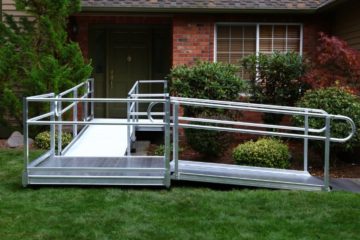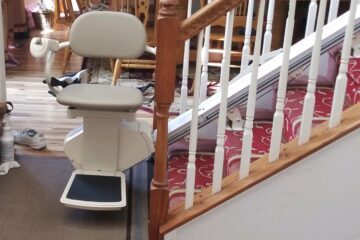A portable wheelchair ramp is a ramp designed for temporary or on-the-go use to provide wheelchair and mobility scooter users with access to buildings, vehicles, or other locations that may have steps, curbs, or uneven surfaces. Portable ramps are typically lightweight, easy to transport, and can be set up and removed as needed. They are a convenient accessibility solution for individuals with mobility challenges who require a smooth transition between different surfaces. Here are some key features and types of portable wheelchair ramps:
- Lightweight Materials: Portable ramps are usually constructed from lightweight materials such as aluminum, fiberglass, or durable plastics. This makes them easy to carry and transport.
- Folding or Telescoping Design: Many portable ramps have a folding or telescoping design, allowing them to collapse into a compact size for easy storage and transportation. Some ramps can fit in the trunk of a car.
- Various Lengths: Portable ramps come in various lengths to accommodate different height obstacles. They can range from a few feet to several feet in length, and some ramps are designed to be modular, allowing for extension when needed.
- Non-Slip Surface: To enhance safety, portable ramps often feature a non-slip surface or texture to provide traction for wheelchair wheels and prevent slipping.
- Weight Capacity: Portable ramps are typically rated for a specific weight capacity. It’s important to choose a ramp that can safely support the weight of the user and their mobility device.
- Threshold Ramps: Some portable ramps are designed specifically for bridging small height differences, such as door thresholds or small curbs. These are known as threshold ramps.
- Suitable for Indoor and Outdoor Use: Portable ramps can be used both indoors and outdoors to provide accessibility in various environments.
- Temporary or Permanent Use: While they are designed for temporary use, some individuals may choose to use portable ramps semi-permanently, depending on their needs.
- Setup and Removal: Portable ramps are easy to set up and remove. They typically have handles or carrying bags for convenience during transportation.
Common uses for portable wheelchair ramps include:
– Providing access to homes and buildings with steps or uneven entrances.
– Facilitating wheelchair access to vehicles, such as vans or SUVs.
– Creating temporary access ramps at events, exhibitions, or outdoor venues.
– Ensuring accessibility for travel, including hotels and public transportation.
– Bridging small obstacles like curbs, thresholds, or small gaps.
When choosing a portable wheelchair ramp, it’s essential to consider factors such as the height of the obstacle, the weight capacity required, the length of the ramp, and whether it will be used indoors or outdoors. Proper selection and use of a portable ramp can significantly improve accessibility and the quality of life for individuals with mobility challenges.


